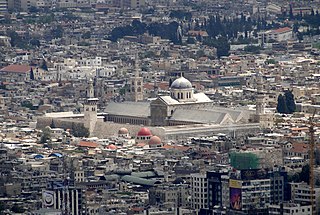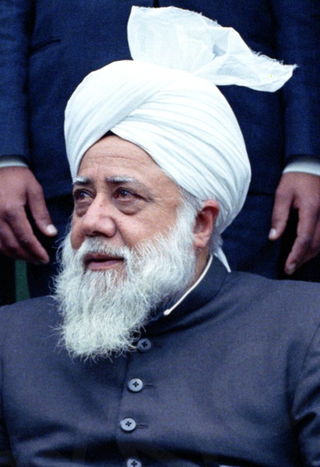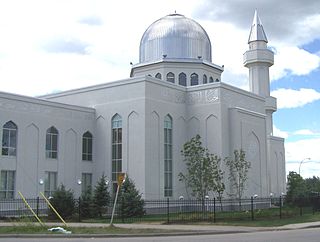
Islam is the second largest religion in the Netherlands, after Christianity, and is practised by 5% of the population according to 2018 estimates. The majority of Muslims in the Netherlands belong to the Sunni denomination. Many reside in the country's four major cities: Amsterdam, Rotterdam, The Hague and Utrecht.

The London Central Mosque is an Islamic place of worship located on the edge of Regent's Park in central London.

The Umayyad Mosque, also known as the Great Mosque of Damascus, located in the old city of Damascus, the capital of Syria, is one of the largest and oldest mosques in the world. Its religious importance stems from the eschatological reports concerning the mosque, and historic events associated with it. Christian and Muslim tradition alike consider it the burial place of John the Baptist's head, a tradition originating in the 6th century. Two shrines inside the premises commemorate the Islamic prophet Muhammad's grandson Husayn ibn Ali, whose martyrdom is frequently compared to that of John the Baptist and Jesus.

The Baitul Futuh is a mosque complex of the Ahmadiyya Muslim Community, situated in Morden, London. It is one of the largest mosque complexes in Europe. Completed in 2003 at a cost of £15 million, entirely from donations of Ahmadi Muslims, the Mosque can accommodate a total of 13,000 worshippers. The main mosque has a height of 23m above ground, and to maximise capacity the building extends below ground. Baitul Futuh is located in the south-west London suburb London Borough of Merton. It is situated next to Morden South railway station, 0.4 miles from Morden Underground station and one mile from Morden Road tram stop.

Berlin Mosque in Berlin is situated on Brienner Straße 7-8 in Berlin-Wilmersdorf. It was designed by K. A. Hermann and was built between 1923 and 1925. Berlin Mosque, which has two 27-metre-tall (90 ft) minarets, was heavily damaged in World War II. The two minarets were rebuilt in 1999/2001.

Mirza Nasir Ahmad was the third Caliph of the Ahmadiyya Muslim Community from Pakistan. He was elected as the third successor of Mirza Ghulam Ahmad on 8 November 1965, the day after the death of his predecessor and father, Mirza Basheer-ud-Din Mahmood Ahmad.

The Fazl Mosque also known as The London Mosque, is the first purpose-built mosque in London, England. It was opened on 23 October 1926 in Southfields, Wandsworth. At a cost of £6,223, the construction of the mosque and the purchase of the land on which it stands, was financed by the donations of Ahmadi Muslim women in Qadian, Punjab, British India. Between 1984 and 2019 the Fazl Mosque was the residence of the caliphs of the Ahmadiyya Muslim Community, and therefore its de facto international headquarters. The administrative headquarters now lies at the site of the Islamabad, Tilford.

Baiturrahman Grand Mosque is a mosque located in Banda Aceh, Aceh, Indonesia. The Baiturrahman Grand Mosque is a symbol of religion, culture, spirit, strength, struggle, and nationalism of the Acehnese people. The mosque is a landmark in Banda Aceh and has survived the 2004 Indian Ocean earthquake and tsunami.

The Baitun Nur is a mosque in Calgary, Alberta. It is located in the Castleridge community of Calgary. The cornerstone of the mosque was laid in 2005. Construction was completed in 2008 at an estimated self-funded cost of C$15 million, with roughly C$8 million coming from the approximately 3,000 local Ahmadi Muslims. It is the largest mosque in Canada.

Khadija Mosque is a mosque located in Heinersdorf, Pankow, Berlin, Germany. It is property of the Ahmadiyya Muslim Community, and the first mosque in former East Germany, opening on 16 October 2008. The mosque has a 12-metre-high (39 ft) minaret and has capacity for 500 worshippers. The mosque was financed by funds collected by Ahmadiyya women and the design was done by the architect Mubashra Ilyas.

The Mahmood Mosque, situated in Forchstrasse, Zurich, is the first purpose-built mosque in Switzerland. It is owned and run by the Ahmadiyya Muslim Community. The mosque has a minaret, the new construction of which is now banned in Switzerland by popular vote.

The White Minaret is a stone minaret beside the Aqsa Mosque in Qadian, Punjab. It was constructed under the direction of the Indian religious leader Mirza Ghulam Ahmad. It serves as a lighthouse symbolising the ultimate pre-eminence of Islam.

The Ahmadiyya Anjuman Isha’at Islam Mosque Keizerstraat is the headquarters of the Lahore Ahmadiyya Movement in Paramaribo in Suriname, the Surinaamse Islamitische Vereniging. The mosque is located in the Keizerstraat, adjacent to the Neveh Shalom Synagogue.

The Aqsa Mosque in Rabwah is the main and largest mosque of the Ahmadiyya Muslim Community in Pakistan. Its foundation stone was laid down in 1966. The mosque was inaugurated on 31 March 1972 by the head of the worldwide community, Mirza Nasir Ahmad. The building can accommodate up to 20,000 worshippers.

Ahmadiyya is an Islamic branch in Switzerland, under the spiritual leadership of the caliph in London. The Community was founded on October 13, 1946, during the late period of the Second Caliphate, when the caliph directed Shaikh Nasir Ahmad to establish a mission in the country. Today there are two Ahmadi mosques and 14 local branches, representing an estimated 800 Ahmadi Muslims.

Ahmadiyya, called Ahmadis is a community under the leadership of the caliph in London. The earliest history of the Community in the country begins in 1956, during the Second Caliphate, when Kamal Yousuf was appointed as the head of the mission in Sweden. However it was not until 1970 that the Community was first officially registered. Today, there are two purpose-built mosques, one of which is the oldest in the country, and also a number of other centers, representing an estimated average of 1600 Ahmadis in the country.

The Aqsa Mosque is the largest and oldest mosque of Qadian, India. It is situated inside the compound of the ancestrial house of Mirza Ghulam Ahmad, close to the White Minaret, and located in the Ahmadiyya Mohallah of Qadian.

The Nusrat Jahan Mosque or The Nusrat Djahan Moske is an Ahmadiyya Mosque built on the outskirts of Copenhagen, Denmark in Hvidovre.

The Mubarak Mosque is a mosque in Tilford, Surrey, England, on the site of the international headquarters of the Ahmadiyya Muslim Community, formally known as Islamabad, Tilford. It was inaugurated on Friday 17 May 2019 by Mirza Masroor Ahmad, the fifth caliph of the Ahmadiyya Muslim Community.


















